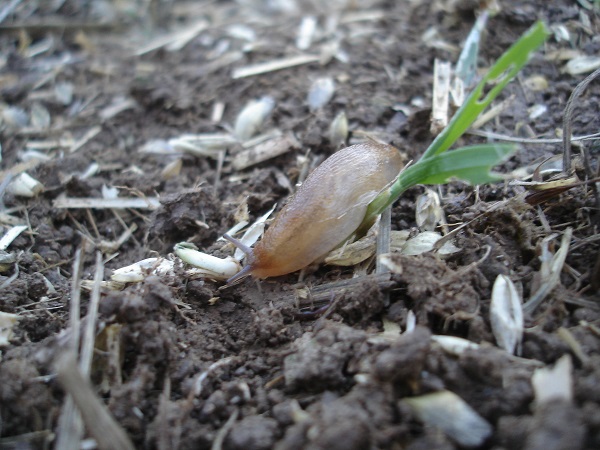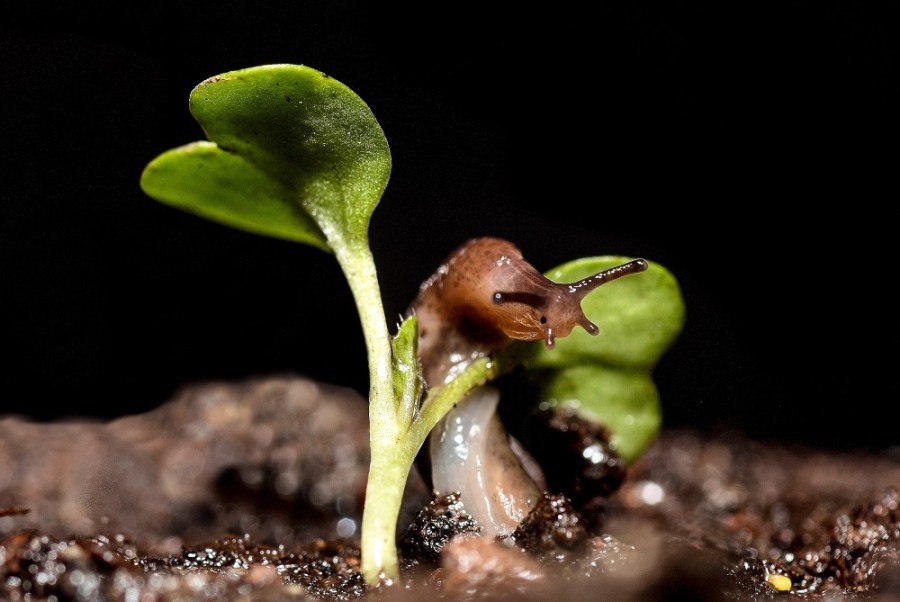With metaldehyde in its use up period, this autumn will see the transition to ferric phosphate as the UK’s only molluscicide. CPM asks agronomists how they view they switch.
It’s been an easier transition from metaldehyde than it might have been.
By Rob Jones
NOTE: This article was written before the High Court ruling that has effectively overturned the Defra decision to withdraw products containing metaldehyde.
With the notice of removal in Dec of last year for commercial use of metaldehyde, UK growers have had to come to terms with the fact that outdoor use of the active will be phased out over 18 months, giving them time to adopt alternative ways of controlling slugs.
Frontier Agriculture crop production technical lead Paul Fogg says the transition away from metaldehyde has been easier than expected, despite UK growers being left with a potentially huge dilemma of how to adequately protect arable and vegetable crops from slug damage.

Lessons learned from the metaldehyde stewardship initiative remain as relevant now, even though the active has been withdrawn.
Although the metaldehyde stewardship programme provided a much more prescriptive approach to slug control and ultimately water quality management, lessons learned from the initiative, first set up in 2008, remain as relevant now even after the active has been withdrawn.
Paul believes that the scheme’s ‘Get Pelletwise’ guidelines for growers, has led to a much-enhanced understanding of how and when slug control products should and can be used for maximum efficacy and cost effectiveness over the past decade.
Ferric phosphate in the form of Sigon (2.42%) formulated in an advanced wet process durum wheat-based pellet, is now one of the company’s products of choice and is being very well received by clients, says Paul.
“It was obvious that with metaldehyde, a lot of work had to be done in order to protect water quality,” he explains. “We made huge strides in identifying and evolving best practice, leading to less prophylactic ‘blanket’ applications and far more prescriptive and targeted use of product, involving more test baiting and identification of population thresholds. This, coupled with the stewardship guidelines, led to a much-reduced use of active ingredient without necessarily compromising efficacy.
“Now that metaldehyde has been removed, that time spent in adopting a new control strategy has served us well, in as much as we use the ferric phosphate product in exactly the same way, achieving the same level of efficacy and persistence,” he says. “Being able to test the two products side by side over the past few years has also meant that trials have been relatively easy to assess.”
Paul explains that because of the different mode of action of ferric phosphate, no tell-tale slime trail is left following ingestion. Slugs then tend to retreat below ground before dying, so there’s not such a graphic picture of mortality. But damage reduction is still very quantifiable, he says, by looking for the cessation of grazing and the percentage improvement in crop heath and viability.
“Application is another area where we have utmost confidence in the product,” he explains. “The dimensions and ballistic properties of the 2.7mm pellet size, mean that it spreads in an identical way to the wet process metaldehyde equivalent pellet and, to be honest, as long as application guidelines are followed and conditions observed, then the coverage is excellent.
“The size of the pellet means that there are fewer baiting points than with some alternative brands of ferric phosphate. But if used at 7kg/ha you are still getting 42 baiting points/m2,” he explains.
“We need to maximise margins and keep costs down for our growers, wherever they are, and adopting a policy of targeted slug control with ferric phosphate is the key to good crop establishment whilst keeping the number of passes to a minimum.”
Sigon can be applied at a maximum individual dose of 7kg/ha with a maximum total dose of 28kg/ha per crop per year across a broad range of arable crops, with best results being achieved by applying before damage occurs and upon risk assessment of the likelihood of damage to a particular crop.
“It’s certainly been an easier transition from metaldehyde than it might have been,” adds Paul. That’s a view that Sussex-based Procam agronomist Mike Thornton shares. Continued successful trials and experimentation with ferric phosphate, has led him to believe that it’s not only providing just as good efficacy, but is affording his growers the chance to implement better environmental stewardship without suffering crop loss.
On his OSR crops, unpredictable flea beetle control has meant that establishment of strong healthy plants is critical, and even more so where hybrid and Clearfield varieties are being used at lower seed rates.
“Where seed rates of 40-50 seeds/m2 are commonplace, it means that often a more prophylactic application at drilling or emergence is necessary to ensure plant survival,” he advises.
“The persistence and longevity of the pellet is good,” he explains. “But not just that, it also demonstrates good ballistic properties when spreading and I can confidently get good coverage by my operators at 15m, even on hillsides and in difficult conditions. The 5-7kg/ha rate coupled with the 2.7mm size of the pellet, means that although the number of baiting points/m2 isn’t huge, the greater surface area to volume ratio, means that the active delivery is very focused.”
Ferric phosphate stops slugs feeding almost immediately, but they often retreat below the surface and die 3-6 days after application. Sometimes it can be less visually obvious when it comes to determining its efficacy, so a net increase in crop improvement is a better indicator than dead slugs.
“Naturally we assess on a field-by-field basis,” he points out. “And where damage persists, we can use a total of 28kg/ha per crop per year.”
The product also has its advantages in cereals on his farms, especially where high, stacked doses of pre-emergence herbicide can have an adverse effect on emerging cereals, making them more vulnerable to slug activity.
Mike believes that with the loss of Deter (clothianidin) seed dressing in cereal crops, which also played a role in slug control, there’s even more justification in applying ferric phosphate.
“Cropping history, late drilling, cooling seedbeds and wet conditions, are all scenarios which could mean crops are at a higher risk of slug attack and can benefit hugely from slug control measures,” he adds “I believe the worries over the loss of metaldehyde are mainly unfounded. Thanks to ferric phosphate, it certainly isn’t the disaster we thought it was going to be.”
New ferric phosphate formulation available
A new player has arrived in the ferric phosphate market, offering more choice to growers. Ironclad is the first UK manufactured ferric phosphate slug pellet and is being marketed by Gemini Agriculture and manufactured by approval holder Doff Portland in Nottingham.
James Kennedy, commercial manager at Gemini Agriculture believes having a UK production site not only allows for rapid response to demand, but also supports British farmers by using British wheat in the production process.
“Following the revocation of metaldhyde, farmers have lost a great deal of choice when it comes to slug control, not only in terms of active ingredient but also pellet formulation,” he says.
Doff has developed a special formulation for the manufacture of Ironclad. ‘Duratech’ is an advanced steam extrusion process using a balance of moisture and temperature to achieve starch gelatinization. This results in a robust pellet at a competitive price, comments James.
Jon Dymock, registration manager at Doff Portland, believes Ironclad will perform well under UK condition: “Replicated UK field trials and simulated rain trails have proven that the integrity of the pellet is maintained even in wet weather. As a result, Ironclad has been approved as having a rainproof formulation.”
He goes on to say, “Our trials program has proven Ironclad’s efficacy compared to current ferric phosphate standards, not only in terms of slug mortality but also the level of crop protection provided.”
“An integrated approach to slug control should be considered,” adds James. “Pellet application is just one option in the toolbox available to farmers. More invasive types of cultivation techniques can help reduce populations.
“Using an appropriate seed rate or increasing rates in ‘hotspot’ areas will help establish the desired number of plants. And creating a fine, consolidated seedbed will not only improve the seed-to-soil contact allowing rapid establishment, but also reduces the slug’s ability to move between emerging seedlings. Slug trapping and crop inspection are also vital in assessing the population and level of crop damage before deciding if a pellet application is required.”
He also highlights the importance of machinery preparation “Before any application a spreader must be setup and calibrated with the pellet of choice to ensure even coverage. Ironclad has been tested through a number of spinning disk applicators and the settings for these machines can be found on the Gemini Ag website. These setting should be considered as a guide and tray test calibrations should also be conducted to allow for adjustments to individual machines.”
“Ironclad has come to market just in time to provide farmers and agronomists with choice. In Ironclad’s use of Duratech, we offer an alternative formulation to other available ferric phosphates pellets. It’s robust and reliable and supplied at a competitive price that will help farmers to keep their cost of production down,” he concludes.




